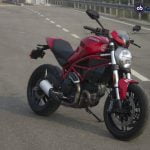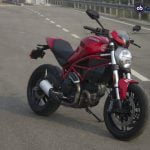
Back in the ’60s, young, carefree riders in America used to strip their motorcycles bare, use knobbly tyres, beef up the suspension and ride across the rather treacherous desert passages. These bikes used to be called desert sleds. The ’60s was also the Scrambler era, also stripped down bikes for use both on tarmac and off it. The Scramblers were similar motorcycles to the desert sleds, the difference is that the desert sleds were built more with hard-core off-road in mind, particularly around the deserts of California and the Baja peninsula.
 (The Ducati Scrambler Desert Sled looks lean and mean)
(The Ducati Scrambler Desert Sled looks lean and mean)Ducati launched the new Scrambler a couple of years ago in four iterations. While the bike was welcomed with enthusiasm, purists thought that the regular Ducati Scrambler could do with some updates in order to make it more off-road friendly. And lo! Ducati launched the Scrambler Desert Sled a few months ago, in India that is. In fact, the Desert Sled is all that and more, what was originally envisioned as the new Ducati Scrambler. And more than just a cosmetic ‘scrambler’ design. We got a chance to spend some time with the Ducati Scrambler Desert Sled and here is what we felt about it.
Looks and design
Lean and mean describes it best. The Desert Sled has a narrow, sinewy look to it, which I’m a big fan of. The panels and certain parts such as the tank and headlamp are borrowed from the regular Scrambler. A first look, it might make you think that the Desert Sled is exactly the same as the regular models, but that would be a mistake. The first big difference is the high set front mudguard and the headlamp with the mesh cover, setting the tone for the looks of a bike, which is meant to be ridden on dirt. Then you have the thick 46 mm front USD forks (the regular Scramblers get 41mm forks upfront). A closer look confirms that the Desert Sled indeed has a taller stance as compared to the other Scramblers. In our opinion, the bike looks dashing!
Features and equipment
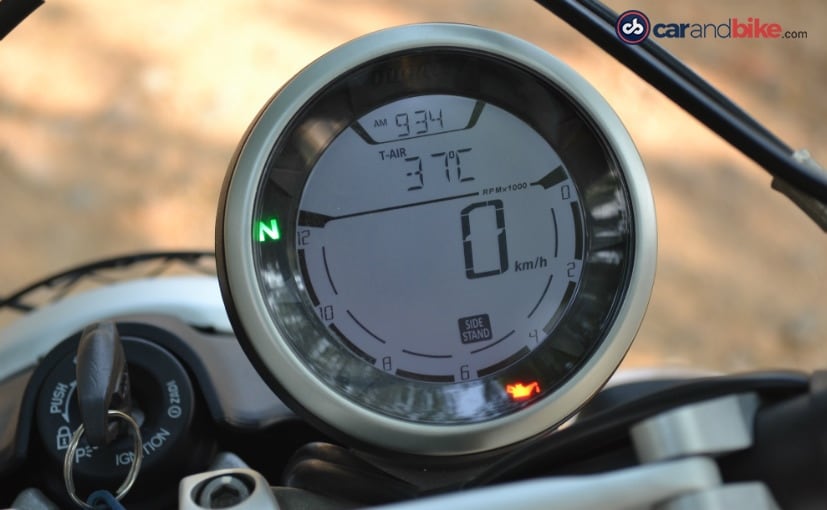 (The single pod instrumentation is old-school and looks cool too)
(The single pod instrumentation is old-school and looks cool too)As is with the Scramblers, the Desert Sled too gets limited equipment and features. The standard equipment list includes LED ring on the headlamp, LED tail lamp, underseat stowage with USB charging point, an LCD instrument console, switchable ABS, protection for front forks and aluminium panels on the tank which are interchangeable.
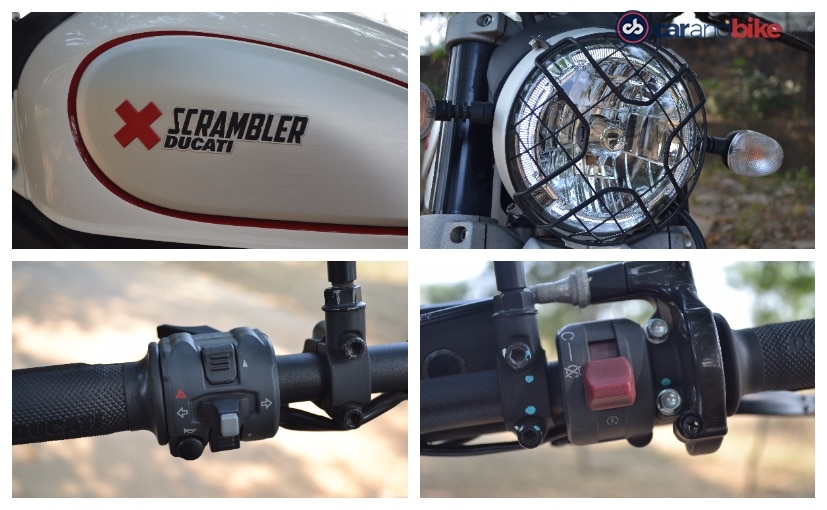 (The Desert Sled shares parts and components from the regular Scrambler)
(The Desert Sled shares parts and components from the regular Scrambler)You do not get exotic electronics such as traction control, ride-by-wire, riding modes and so on and honestly, you can live without those. Having said that, there are a few essentials which are missing too! The instrument console does not have a fuel gauge and a gear position indicator. There is a tell-tale light for neutral and minimum fuel level though.
Chassis and suspension
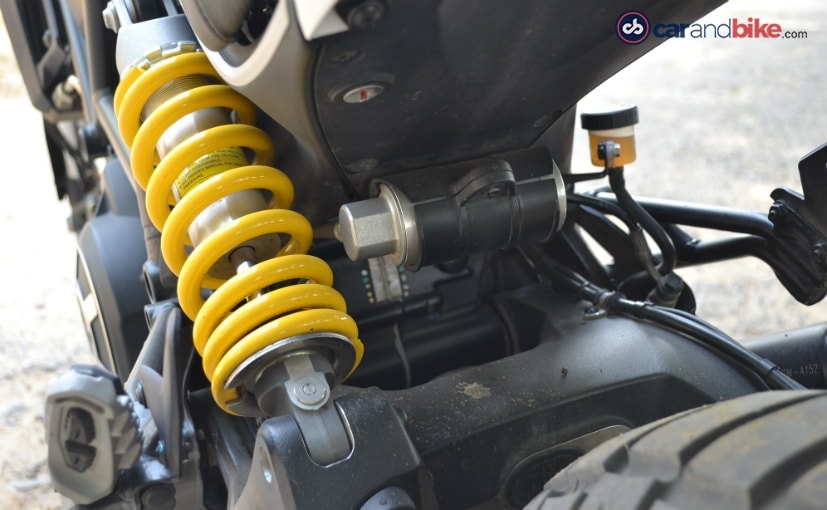 (The travel on both suspension units is 200 mm)
(The travel on both suspension units is 200 mm)The chassis is where the bike gets a whole lot of updates. You can see new tubing on the engine perimeter which increases the stiffness of the chassis. Then you have a stronger swingarm which is also longer than the ones on the regular Scramblers.
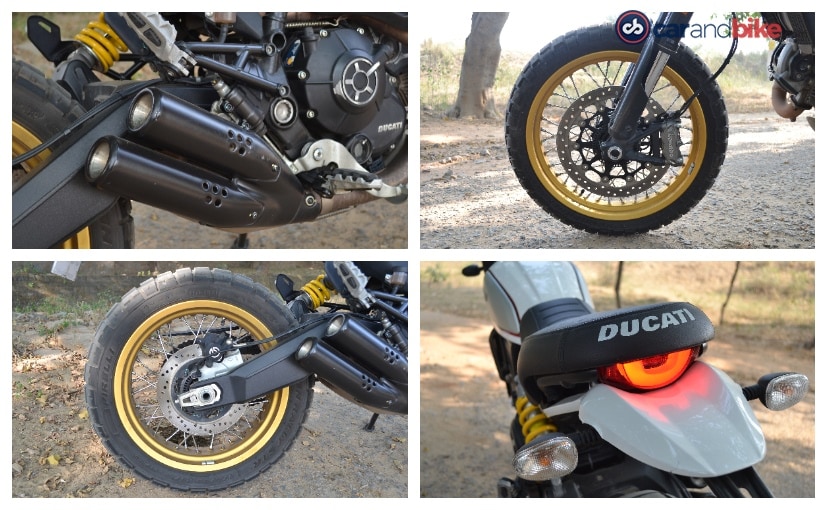 (The Desert Sled gets off-road spec bits such as the dual-purpose Pirelli Scorpion Rally STR tyres)
(The Desert Sled gets off-road spec bits such as the dual-purpose Pirelli Scorpion Rally STR tyres)As we mentioned earlier, the bike gets meatier 46 mm USD forks upfront and an off-set Kayaba monoshock at the rear. Both units have 200 mm of travel along with dual-purpose Pirelli Scorpion Rally STR tyres. The front wheel is a 19-inch unit while the wheel at the rear is a 17-inch one. Both are wire-spoked of course. Our short spin on tarmac and off it revealed that the tyres offer excellent grip and stability. Impressive indeed!
Engine and performance
The engine is the same as the regular Scrambler, which is an 803 cc L-twin motor making 72 bhp at 8,250 rpm and 67 Nm of peak torque at a low 5,750 rpm. There is a lot of grunt in the bottom and mid-range which makes life a lot easier when riding in the city or going off the road. The bike pulls cleanly and builds up speed in a smooth manner, without any of the irregular, jerky throttle response that the first generation new Scramblers were known to have.
 (The engine is a 803 cc, L-twin unit making 72 bhp and 67 Nm)
(The engine is a 803 cc, L-twin unit making 72 bhp and 67 Nm)Clearly, the switch over to meet the latest emission norms have resulted in a much smoother throttle. Off the road, the bike feels natural and this makes it easier for the rider to explore his/her abilities. The handlebar is wide and it is easy to grip the tank with your knees when standing up. Switch off the ABS and you are ready for some shenanigans and hooliganism. As far as ability is concerned, the Desert Sled is just a dirt-bike on steroids and will be more than happy to take on any challenge that you throw at it.
What we think!
 (The Desert Sled is a good off-road bike, but the pricing could have been kept lower)
(The Desert Sled is a good off-road bike, but the pricing could have been kept lower)At ₹ 9.32 lakh (ex-showroom, Delhi) the Desert Sled might seem a tad expensive but its well-worth it. It is a bike which looks good and means business. Road or no road, the Desert Sled will be more than happy to tackle it all with you at the helm. The only downside that we can think of is the heat dissipating from the engine when riding in traffic. It might not be a cross-country tourer but on tough terrain it can stand head-to-head with the best adventure bikes and maybe even do one better.
[“source=auto.ndtv”]




